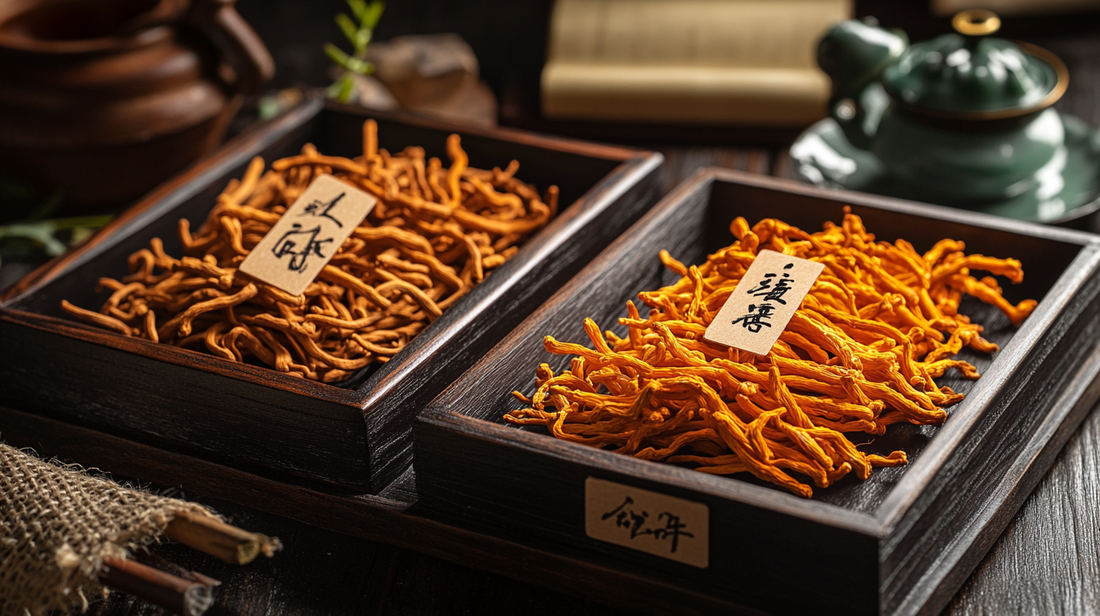
Cordyceps Sinensis vs Militaris: What’s the Difference?
Share
Introduction
Cordyceps is one of the most revered fungi in Traditional Chinese Medicine (TCM), celebrated for its ability to enhance vitality, stamina, and overall resilience. Two species dominate the conversation: Cordyceps sinensis and Cordyceps militaris. Though they share some similarities, they also have distinct differences that affect their use, effectiveness, and accessibility.
In this blog, we’ll explore the origins, properties, benefits, and differences between Cordyceps sinensis and Cordyceps militaris, so you can make an informed choice.
Origins and Cultivation
Cordyceps sinensis, also known as "caterpillar fungus," grows naturally at high altitudes on the Tibetan Plateau. It parasitises the larvae of ghost moths and is highly prized in TCM for its powerful tonifying properties. Wild Cordyceps sinensis has historically been rare and expensive, leading to the development of cultivated versions.
Cordyceps militaris, by contrast, can be cultivated easily on plant-based substrates in controlled environments. It does not require an insect host, making it more sustainable and widely available. Advances in cultivation methods have significantly improved the quality and potency of militaris varieties.
Journal of Ethnopharmacology (2021): Cultivated Cordyceps militaris demonstrates comparable, and sometimes superior, levels of active compounds compared to wild Cordyceps sinensis.
Key Active Compounds
Both species contain bioactive compounds that contribute to their health benefits, including:
- Cordycepin (3'-deoxyadenosine)
- Adenosine
- Polysaccharides
- Beta-glucans
However, the concentration varies.
Cordyceps militaris typically has higher levels of cordycepin, a compound with strong anti-inflammatory, antioxidant, and immune-modulating properties. Cordyceps sinensis has a broader range of bioactive molecules but often in lower individual concentrations, especially in cultivated forms.
Health Benefits Compared
Energy and Stamina
Cordyceps has long been used to enhance physical endurance by improving oxygen uptake and mitochondrial efficiency.
- Cordyceps sinensis has traditionally been prescribed for fatigue, altitude sickness, and recovery from illness.
- Cordyceps militaris shows potent effects in modern research for increasing endurance and reducing exercise-induced fatigue.
Immune System Support
Both species stimulate innate immunity, enhancing natural killer (NK) cell activity and modulating inflammatory pathways. Militaris’s higher cordycepin content gives it a slight edge in direct immune regulation.
Respiratory Health
Cordyceps sinensis is particularly valued for nourishing Lung Qi in TCM, helping with chronic coughs, asthma, and shortness of breath. Militaris supports similar functions but is often used in a broader context of energy support rather than targeted Lung conditions.
Anti-Aging and Antioxidant Effects
Both species exhibit strong antioxidant properties, scavenging free radicals and reducing oxidative stress linked to aging. Cordyceps militaris, due to its cordycepin content, may offer a more pronounced anti-inflammatory and anti-aging effect.
Frontiers in Pharmacology (2022): Cordyceps militaris extracts demonstrated significant neuroprotective and anti-inflammatory benefits in aging models.
Traditional Use vs Modern Application
Cordyceps sinensis holds a legendary place in TCM history. It is seen as a "precious tonic" for the Kidneys and Lungs, promoting essence (Jing) and balancing Yin and Yang. It was reserved for emperors and nobility.
Modern TCM clinics, including Vital Duo, often use cultivated sinensis CS-4 in customised formulas to support deep constitutional deficiencies.
Cordyceps militaris, while newer to clinical practice, fits seamlessly into modern wellness needs. It is used widely for immune modulation, anti-inflammatory support, energy enhancement, and sports recovery protocols.
Accessibility and Cost
Wild Cordyceps sinensis is extremely rare and commands astronomical prices, often exceeding £20,000 per kilogram. Even cultivated sinensis remains expensive due to complex growing conditions.
Cordyceps militaris offers a much more accessible alternative. High-quality organic militaris extracts provide potent therapeutic value at a fraction of the cost, making daily supplementation realistic for a broader population.
How to Choose Between Sinensis and Militaris
- Choose Cordyceps sinensis if you seek deep Kidney and Lung tonification, are recovering from chronic illness, or require a classic TCM constitutional support.
- Choose Cordyceps militaris if you want a powerful, everyday adaptogen to boost stamina, immunity, inflammation control, and anti-aging effects.
Patient Experience at Vital Duo
A 52-year-old patient recovering from COVID-related fatigue benefited from a customised herbal formula including cultivated Cordyceps sinensis. After 8 weeks, they reported improved energy, better sleep, and fewer respiratory symptoms.
Meanwhile, a 28-year-old athlete used Cordyceps militaris supplementation to enhance training recovery and immune resilience during competition season. They noted faster recovery times and improved stamina after just 4 weeks.
Safety and Precautions
Cordyceps, whether sinensis or militaris, is generally safe for long-term use. Minor side effects, such as digestive upset or dry mouth, are rare and typically resolve with dosage adjustment.
Individuals with autoimmune diseases or those on immunosuppressant medications should consult a qualified practitioner before starting Cordyceps.
Final Thoughts
Cordyceps sinensis and Cordyceps militaris each hold immense value, rooted in both ancient tradition and modern science. Whether you are seeking deep constitutional restoration or daily resilience, understanding the differences between these two species allows you to make the right choice for your health goals.
Academic References
- Journal of Ethnopharmacology. (2021). Comparative Study of Cordyceps Sinensis and Militaris Bioactivity
- Frontiers in Pharmacology. (2022). Cordyceps Militaris and Neuroinflammation in Aging
- Chinese Herbal Medicine Materia Medica (3rd Edition). Cordyceps Applications in Traditional Chinese Medicine
